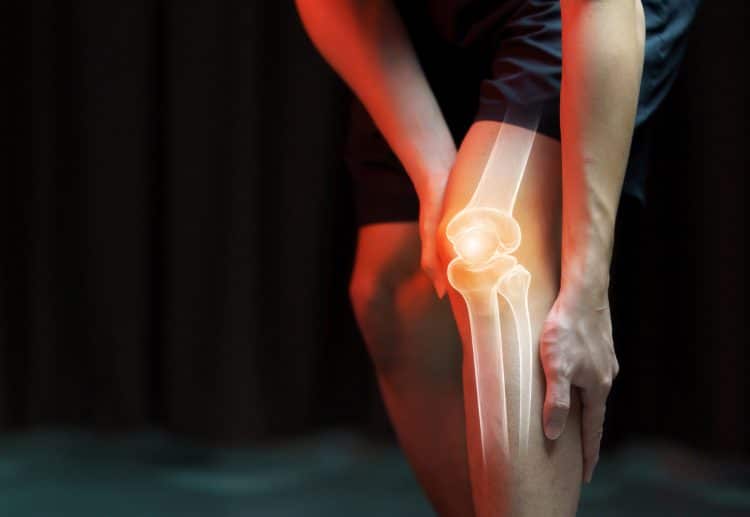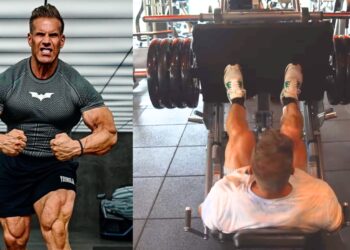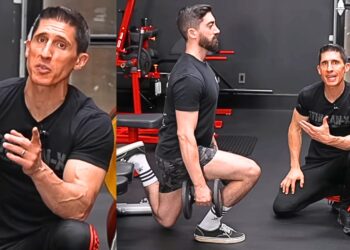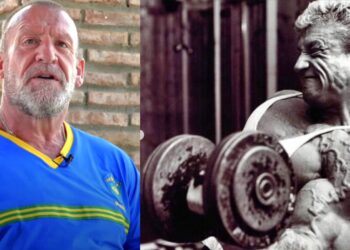Many believe that squats are the only exercise you need to do to blow up your quads. Social media is full of content extolling the benefits of squats, especially the ass-to-grass variation.
However, since squats are a compound exercise they work several other muscles besides the quads. Plus, some people, especially taller lifters, find them uncomfortable, and squatting to failure can result in severe injury.
You must include isolation exercises in your leg workouts to hammer your quads. As a personal trainer with over 35 years in the trenches, I have helped several people build jacked wheels with nothing more than quad isolation exercises. In this article, I reveal the eight best quad isolation exercises you must add to your arsenal.
Recent Updates: On June 5, 2024, Fitness Volt’s Senior Editor, Vidur Saini (American Council on Exercise-CPT), revised the exercise list and added actionable expert tips throughout the piece to improve the reader experience.
Level Up Your Fitness: Join our 💪 strong community in Fitness Volt Newsletter. Get daily inspiration, expert-backed workouts, nutrition tips, the latest in strength sports, and the support you need to reach your goals. Subscribe for free!
8 Best Quad Isolation Exercises
Below are the eight must-do quad isolation exercises:
- Machine Leg Extensions
- Dumbbell Leg Extensions
- Leg Extensions – Isometric Holds
- Single-Leg Resistance Band Leg Extension
- Bodyweight Leg Extension
- Sissy Squat
- Wall Squats
- Seated Straight Leg Raise
1. Machine leg extensions
| Sets & Reps | Equipment Needed | Target Muscles |
| 3 x 8-12 | Leg extension machine | Quadriceps (emphasis) |
The leg extension machine is arguably the daddy of quad isolation exercises. With all the movement coming from the knee, this is the truest way to isolate your quadriceps. Because it’s performed while sitting upright, the rectus femoris is in a relaxed position and not as active as it could be. However, the three vastus muscles are all working hard during this exercise.
Saini recommends keeping your toes pointed during this exercise to further lengthen the quads and achieve a deep target muscle contraction at the top of your range of motion (ROM).
How to do it:
- Sit on a leg extension machine, so your knees align with the lever arm pivot point. Adjust the backrest for comfort and support.
- Place your ankles behind the lower leg pad. Grip the handles by your sides.
- Smoothly extend your legs until your knees are straight. Do not kick the weight up, as doing so creates momentum and takes tension off your quads.
- Pause in the top position for 1-2 seconds.
- Bend your knees and lower the weights but do not let them touch to keep the tension on your quadriceps.
- Extend your legs and repeat.
Pro tip: Perform this exercise one side at a time to better isolate the quads.
| Difficulty | Progression | Regression |
| Beginner | Slow down the eccentric (lowering) phase | Banded leg extensions |
2. Dumbbell leg extensions
| Sets & Reps | Equipment Needed | Target Muscles |
| 3 x 12-15 | Dumbbells | Quadriceps (emphasis) |
The machine leg extension might be the best way to isolate your quads, but that’s no help if you train at home and don’t have the necessary equipment. Thankfully, you can also do leg extensions with a single dumbbell.
“Control the eccentric (lowering) phase for a full 3 seconds to increase the TUT and maximize quad fiber stimulation,” Saini says.
How to do it:
- Sit on the end of an exercise bench with the backs of your knees against the edge. Hold a dumbbell between your feet.
- Squeezing your feet and legs together, extend your legs until they’re straight.
- Bend your legs and repeat.
Pro tip: Bring your heels as close to your butt as possible to achieve a deep quad stretch at the bottom of your ROM.
| Difficulty | Progression | Regression |
| Beginner | Machine leg extensions | Bodyweight extensions |
3. Leg extensions – isometric holds
| Sets & Reps | Equipment Needed | Target Muscles |
| 3 x 30-60 seconds | Leg extension machine | Quadriceps (increased time under tension) |
Isometric training involves holding a weight or maintaining a static position against resistance rather than moving through a range of motion. This unique approach allows you to engage muscles with greater intensity, potentially exceeding your usual lifting capacity and subjects them to continuous tension for enhanced strength and stability.
Leg extension isometric holds really hammer your quads and can help develop better quad separation and more defined legs. However, with no opportunity to relax your quads, lactic acid will build up pretty fast, and your legs will soon start to burn!
How to do it:
- Sit on your leg extension machine, so your knees align with the lever arm pivot point.
- Smoothly extend your legs until your knees are straight.
- Hold your legs straight while tensing your quads as hard as you can.
- Breathe through the pain and keep the weight up for as long as possible.
Pro tip: Do a set of isometric leg extensions before doing regular leg extensions to shock them into growth. Alternatively, finish your workout with isometric holds to wring the last bit of energy out of your muscles.
You can also do this exercise using one leg at a time, i.e., single-leg extension isometric holds.
| Difficulty | Progression | Regression |
| Beginner | Perform closer to full extension | Decrease hold time |
4. Single-leg resistance band leg extension
| Sets & Reps | Equipment Needed | Target Muscles |
| 3 x 15-20 (per leg) | Resistance band | Quadriceps (emphasis), hip flexors, improved stability |
Resistance bands are very versatile, and you can use them to replicate most free-weight and machine exercises. Besides being cheap and portable, most resistance band exercises are also very joint-friendly, as there is no initial inertia to overcome, and the resistance increases gradually.
Saini suggests keeping the anchor point at ankle height to load the quads maximally in the fully lengthened position.
How to do it:
- Sit on a chair or bench and tie a resistance band around one ankle. Anchor the other end on something immovable, such as a heavy dumbbell or your chair/bench leg.
- Extend your leg until your knee is straight.
- Lower your leg and repeat.
- Perform the desired number of reps and then swap legs. Do the same number of reps on both sides.
Pro tip: Make this exercise more comfortable by using an ankle cuff instead of tying the band around your leg.
| Difficulty | Progression | Regression |
| Beginner | Use a stronger resistance band, increase reps | Leg extension isometric holds |
5. Bodyweight leg extension
| Sets & Reps | Equipment Needed | Target Muscles |
| 3 x max reps | None | Quadriceps |
It’s true; you don’t need equipment to isolate your quads! Besides building bigger quads, this exercise can help improve knee and ankle mobility. Kneel on a folded towel or gym mat for comfort.
Saini advises beginners to hold onto a sturdy object for assistance. Perform the exercise with a slow rep cadence to maximize the results.
How to do it:
- Kneel down, so your thighs are vertical. Extend your ankles and press the tops of your feet into the floor.
- Keeping your hips extended, bend your knees and lean back as far as you can, lowering your butt toward your heels.
- Use your quads to push you back into the starting position and repeat.
Pro tip: Make this exercise even more quad-centric by raising your knees on yoga blocks or putting bumper plates under your mat/towel.
| Difficulty | Progression | Regression |
| Moderate | Machine leg extension | Assisted leg extension (use hands to help lift leg) |
6. Sissy squat
| Sets & Reps | Equipment Needed | Target Muscles |
| 3 x 10-12 | None | Quadriceps (emphasis), rectus femoris |
The sissy squat is the first of our semi-isolation exercises. This classic old-school bodybuilding move loads the quads while minimizing joint strain. However, you’ll definitely feel this one in your quads.
Keep your body, from head to knees, in a straight line throughout the movement, cues Saini.
Level Up Your Fitness: Join our 💪 strong community in Fitness Volt Newsletter. Get daily inspiration, expert-backed workouts, nutrition tips, the latest in strength sports, and the support you need to reach your goals. Subscribe for free!
How to do it:
- Stand next to a wall or some other object you can use for balance.
- Rise up onto your tiptoes.
- Push your hips and knees forward and squat down as you simultaneously lean back.
- Descend as far as you can, ideally until your shins are roughly parallel to the floor.
- Drive your toes into the floor and stand back up.
- Tense your quads and glutes at the top of each rep and repeat.
Pro tip: Place your heels on weight plates or blocks to push your knees forward and increase the load on your quadriceps. Make this exercise more intense by holding a single dumbbell by your side or a weight plate against your chest.
| Difficulty | Progression | Regression |
| Difficult | Weighted sissy squats | Partial sissy squats |
7. Wall squats
| Sets & Reps | Equipment Needed | Target Muscles |
| 3 x 60-90 seconds | Wall | Quadriceps, glutes, calves |
The great thing about wall squats is that you can train your quads hard without using equipment. This is another isometric exercise. If you do this exercise using the below-mentioned technique, you’ll thrash your quads in under 30 seconds! This exercise is an excellent leg workout finisher.
Saini recommends actively pushing your lower back into the wall to engage your core muscles and boost stability.
How to do it:
- Lean your back against a wall and place your feet about two feet in front of you. Slide down the wall until your thighs are about parallel to the floor.
- Drive your feet forward and down, and push your lower back into the wall as hard as possible. Try to generate as much muscle tension as possible.
- Keep pushing for 20-30 seconds. If you think you can go for longer, you need to push harder!
Pro tip: Do this exercise before lunges, bodyweight squats, squat jumps, etc., for a much more intense bodyweight-only leg workout.
| Difficulty | Progression | Regression |
| Beginner | Weighted wall squats | Decrease hold time |
8. Seated straight leg raise
| Sets & Reps | Equipment Needed | Target Muscles |
| 3 x 15-20 | None | Quads, hip flexors, lower abdominals |
This quad isolation exercise works the vastus muscles isometrically, while the rectus femoris works isotonically to flex your hip. With no movement at the knee to worry about, this is a very joint-friendly quad exercise that’s often used in rehab and prehab situations. However, it may be too easy for some people to be much of a strength or muscle builder.
Maximize quad contraction by pausing at the top of your ROM, says Saini.
How to do it:
- Sit on the floor with one leg bent and one leg straight.
- Place your hands behind you for balance and support, or lean your back against a wall.
- Contract the quadriceps of the straight leg and point your toe up toward the ceiling.
- Lift your straight leg as high as you can without slouching backward.
- Lower your leg and repeat.
- Do the same number of reps on both legs.
Pro tip: Try turning your hip in or out to emphasize different quad muscles. Turning your hip out will increase vastus medialis engagement, while turning it in will hit the vastus lateralis more.
| Difficulty | Progression | Regression |
| Beginner | Add ankle weights | Perform while seated on a chair. |
What Are the Quad Muscles?
The quads comprise four muscles, each with distinct origins or starting points. These muscles come together at a single insertion point called the quadriceps tendon.
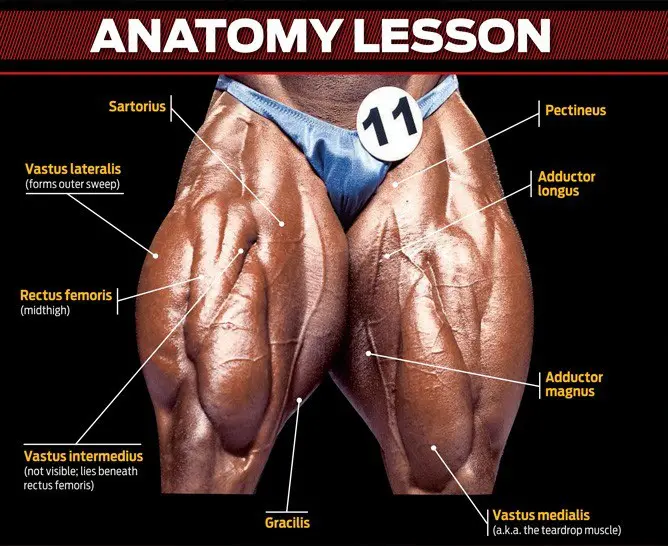
The four quadriceps are:
Rectus femoris
The rectus femoris is the longest of the quadriceps muscles. It’s also biaxial, meaning it crosses two joints. As such, the rectus femoris has two primary functions: knee extension and hip flexion.
Vastus medialis
Where rectus femoris is the longest quadriceps muscle, vastus medialis is the shortest. This muscle is just above your knee and shaped like a teardrop. It’s responsible for straightening the knee and is most active in the last few degrees of extension.
Vastus intermedius
Located between vastus medialis and vastus lateralis, this long muscle really stands out at the front of your thighs. It’s a very powerful knee extensor and makes up much of the bulk of your anterior thighs.
Vastus lateralis
The vastus lateralis is the largest, strongest muscle in the quadriceps group. It’s located on the side of your thigh and gives your quads their width. Well-developed vastus lateralis gives your thighs a pleasing shape, which is often called the quad sweep.
While the quads are made up of four muscles, they come together at a single insertion point, which means you cannot work one without the others. That said, the rectus femoris is more active when your hip is extended, i.e., standing up, and the vastus medialis is more active as your knee reaches full extension. However, when you train your quads, all four muscles are working.
Isolation vs. Compound Exercises – What’s the Difference?
An isolation exercise is one that involves movement at just one joint and targets a small number of muscles. In contrast, compound exercises involve two or more joints and several muscles.
While there are several great quad isolation exercises, there are also several effective compound exercises that emphasize the quads.
To provide you with plenty of choices, we’ve included true quad isolation exercises and a few compound movements that hit your quads particularly well. Think of these latter exercises as semi-isolation, as the quads are doing most of the work.
FAQs
How often should I train my quads?
When it comes to bringing up a lagging muscle, one of the best ways to do it is by training it more often, e.g., two to three times weekly. Rotate exercises and use different set and rep ranges each time you work out to stimulate hypertrophy while avoiding boredom.
How long should I rest between sets?
For most people, 90 seconds to three minutes rest periods works the best. However, you can take longer rests between sets of compound exercises with heavy weights and shorter rests between lighter weights and isolation exercises.
Do you have a good quad-building workout for me to try?
Yes indeed! Do two to four sets of six to 20 reps of the following exercises twice per week, e.g., Monday and Thursday. Take each set to within 1-3 reps of failure:
- Leg extensions
- Sissy squat
- Short step lunges
- Bodyweight leg extensions
Complications Associated with Quad Isolation Exercises
Hopefully, your quads training will go smoothly, and you’ll get the results you want. However, there are a couple of complications associated with leg training and quad isolation exercises you should be aware of.
Knee pain
Some quad-centric and quad isolation exercises put a lot of stress on your knees. Sissy squats are an example of this.
If any of the exercises in this article cause discomfort or knee pain, you should choose less demanding exercises, use less weight, or reduce your workout volume. However, in many cases, strengthening your quads could help alleviate knee pain. Strong quads stabilize your knees and reduce joint wear and tear.
Tight quads
Intense strength training can make your muscles short and tight, especially if you don’t do enough stretching. Tight quads can affect your knees AND hips as they cross both of these joints.
The good news is that the quads are very easy to stretch and respond well to flexibility training. Doing a stretch or two after your leg workout will ensure your quads don’t tighten up. Simply standing on one leg and pulling your heel toward your butt will give your quads a good stretch.
Check out this guide to the best quad stretching exercises.
More Isolation Exercises:
- 60 Best Shoulder Isolation Exercises For Bigger and Peeled Deltoids
- The 9 Best Close Grip Bench Press Alternatives
- Compound vs. Isolation Exercises — The Ultimate Verdict
- 86 Best Isolation Exercises By Muscle Groups
- 8 Training Techniques And Methods To Keep The Muscle Growth Coming
Final Thoughts
There is no denying that squats, leg presses, hack squats, etc., are good lower body exercises, but they work all your leg muscles and not just your quads. For some people, squats and so on are enough to build impressive quads, but others will need to use a more isolation-based approach to training.
Use the eight tried-and-tested quad isolation and emphasizing exercises in this article to build massive, muscular quads. Follow the training guidelines in the FAQ, and you’ll soon be on the way to earning the nickname Quadzilla!
References:
1- PubMed: Effects of resistance training performed to repetition failure or non-failure on muscular strength and hypertrophy https://pubmed.ncbi.nlm.nih.gov/33497853/

